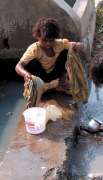 This study report by the Water and Sanitation Programme (WSP), a global partnership administered by the World Bank suggests that inadequate sanitation causes India considerable economic losses, equivalent to 6.4 per cent of India's GDP in 2006 at Rs. 2.4 Trillion. It analyzed the evidence on the adverse economic impacts of inadequate sanitation, which include costs associated with death and disease, accessing and treating water, and losses in education, productivity, time, and tourism. The findings are based on 2006 figures, although a similar magnitude of losses is likely in later years.
This study report by the Water and Sanitation Programme (WSP), a global partnership administered by the World Bank suggests that inadequate sanitation causes India considerable economic losses, equivalent to 6.4 per cent of India's GDP in 2006 at Rs. 2.4 Trillion. It analyzed the evidence on the adverse economic impacts of inadequate sanitation, which include costs associated with death and disease, accessing and treating water, and losses in education, productivity, time, and tourism. The findings are based on 2006 figures, although a similar magnitude of losses is likely in later years.
The study focused on the safe management of human excreta and associated hygiene behavior. The methodology adopted by the study included disaggregating the economic impacts of inadequate sanitation into health-related impacts including premature deaths, costs of treating diseases, and productive time lost due to illnesses; domestic water-related impacts including household treatment of water, and money and time costs to obtain safe water; welfare losses including additional time spent by people for accessing toilets or open defecation sites, and girls having to miss school, and women not going to work; and the loss of potential tourism owing to inadequate sanitation.
Data on incidence (e.g. diarrheal diseases, deaths, etc.) were compiled from national sources (National Family Health Survey, WHO Demographic and Health Surveys, and other Govt. of India sources). Based on scientific literature, attribution factors were used to estimate the populations impacted by inadequate sanitation. Economic valuation was carried out using costs/prices based on secondary studies.
Some of the key points emerging from the study are –
- It quantifies the economic losses to India, and shows that children and poor households bear the brunt of poor sanitation. More than three-fourths of the premature mortality-related economic losses are due to deaths and diseases in children younger than five. Diarrhea among these children accounts for over 47 percent (US$18 billion) of the total health-related economic impacts.
- It indicates that premature mortality and other health-related impacts of inadequate sanitation, were the most costly at US$38.5 billion (71.6 percent of total impacts), followed by productive time lost to access sanitation facilities or sites for defecation at US$10.7 billion (20 percent), and drinking water-related impacts at US$4.2 billion (7.8 percent).
- At 75 percent more than the national average and 60 percent more than the urban average, the poorest 20 percent of households living in urban areas bear the highest per capita economic impacts of inadequate sanitation. Rural households in the poorest quintile bear per capita losses 8 percent more than the average loss for households in rural areas.
- It underlines that substantial investments are needed in improving sanitation as the Government of India's national rural sanitation flagship Total Sanitation Campaign has been providing and as the National Urban Sanitation Policy 2008 has espoused.
- It further recommends a new monitoring framework - one that measures not just toilet coverage and use, or coverage of sewerage and number of wastewater treatments, or number of sanitized communities and cities, but also improvements in the overall health, water-related, environmental, and other welfare indicators that result from inadequate sanitation.
- It estimates that comprehensive interventions (use of toilets, hygiene promotion, improved access to safe water, and proper waste management) can save India US$32.6 billion, or US$29 per capita.
- It also shows that increasing public and household investments in sanitation can generate considerable economy activity - the sanitation 'market' is estimated at about US$152 billion for infrastructure creation and operations and maintenance services, over the period 2007-2020.
Download the report here













